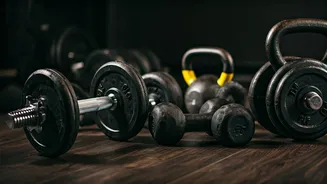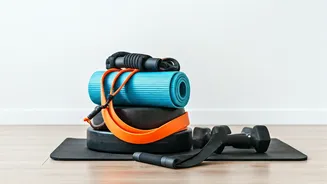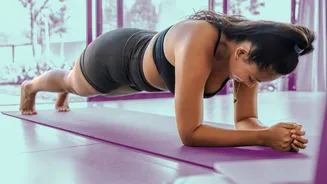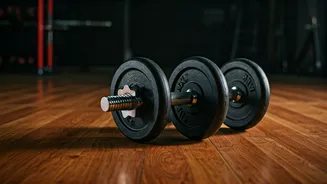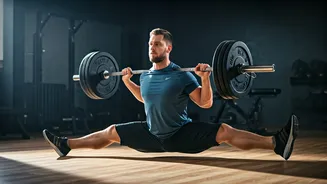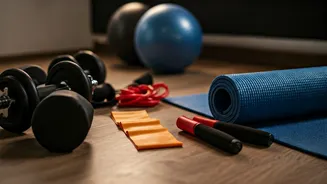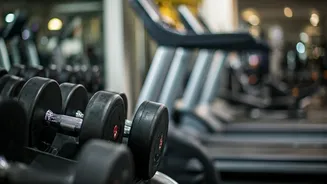Bodyweight Squats
Bodyweight squats are a foundational exercise that works multiple muscle groups simultaneously, making them highly efficient. To perform a bodyweight squat correctly,
stand with your feet shoulder-width apart, toes pointing slightly outward. Keep your back straight, core engaged, and chest lifted as you lower your hips as if sitting in a chair. Aim to go down as far as your mobility allows, typically until your thighs are parallel to the ground. Then, push through your heels to return to the starting position. It's crucial to maintain proper form to avoid injury and maximize the exercise's benefits. For beginners, start with a few sets of 10-12 repetitions. As your strength improves, you can gradually increase the number of repetitions or sets. Focus on controlling the movement and feeling the muscles work. Regular practice can improve lower body strength, enhance balance, and boost overall functional fitness. Bodyweight squats are an excellent starting point for any home-based strength training program.
Chair Dips
Chair dips are a fantastic way to target your triceps and strengthen the upper body without needing any specialized equipment. Find a sturdy chair or bench and sit on the edge with your hands gripping the edge, fingers pointing forward. Slide your hips off the chair while keeping your arms straight, and bend your elbows to lower your body towards the floor until your upper arms are parallel to the ground. Push back up to the starting position using your triceps. This exercise primarily works the triceps, the muscles on the back of your upper arms, but it also engages your shoulders and chest. Adjust the difficulty by modifying the angle of your legs; the closer your feet are to the chair, the easier the exercise. Start with a few sets of 8-10 repetitions and gradually increase the number as you gain strength. Chair dips are a convenient and effective exercise for building upper body strength, easily incorporated into your home workout regime.
Plank Hold
The plank hold is a core-strengthening exercise that challenges multiple muscle groups, including the abdominals, back, and shoulders. Begin in a push-up position, but instead of resting on your hands, support your weight on your forearms. Your elbows should be directly under your shoulders, and your body should form a straight line from head to heels. Engage your core, squeeze your glutes, and hold this position for as long as you can maintain proper form. Start with holding the plank for 20-30 seconds, and gradually increase the duration as your core strength improves. The plank is an isometric exercise, meaning that the muscles are working without any movement. Regular planking can enhance core stability, improve posture, and reduce the risk of back pain. Proper form is paramount; ensure that your hips do not sag or pike, and that you maintain a neutral spine throughout the hold. Aim to incorporate planks into your daily routine for optimal results.
Wall Push-ups
Wall push-ups are an excellent modification of the standard push-up, making them accessible for beginners or those seeking a less intense workout. Stand a comfortable arm's length away from a wall and place your hands shoulder-width apart on the wall, similar to the position for a regular push-up. Keep your body straight from head to heels. Lower your body towards the wall by bending your elbows, and then push back to the starting position. Wall push-ups work the chest, shoulders, and triceps. They are gentler on the wrists and easier to perform than floor push-ups, making them a good option for people with wrist or shoulder issues. The closer you stand to the wall, the more challenging the exercise becomes. Start with a few sets of 10-15 repetitions and gradually increase the number of reps or sets as you gain strength. Wall push-ups are a versatile exercise that can be done anywhere, anytime, providing a simple yet effective way to build upper body strength.
Forward Lunges
Forward lunges are a dynamic exercise that effectively works the legs and glutes, enhancing both strength and balance. Stand with your feet hip-width apart and your hands on your hips. Step forward with one leg, bending both knees to lower your body until your front thigh is parallel to the ground and your back knee hovers just above the floor. Ensure your front knee does not extend past your toes. Push off with your front foot to return to the starting position and repeat on the other side. Lunges are a unilateral exercise, meaning they work one leg at a time, which can help address muscle imbalances. Keep your core engaged throughout the movement to maintain balance. Start with a few sets of 10-12 repetitions per leg. Lunges offer a versatile way to build leg strength, improve balance, and enhance lower body stability. Focus on controlled movements and maintaining proper form to gain maximum benefits and minimize the risk of injury. Regularly performing lunges can significantly improve your overall lower body strength and functional fitness.
Reverse Lunges
Reverse lunges, also known as backward lunges, are another excellent leg and glute exercise variation, offering similar benefits to forward lunges but with a different emphasis. Stand with your feet hip-width apart. Step backward with one leg, bending both knees to lower your body until your front thigh is parallel to the ground and your back knee hovers just above the floor. Maintain the same form cues as in forward lunges, ensuring your front knee doesn't extend past your toes. Push off with your back foot to return to the starting position, and then repeat on the other side. Reverse lunges place slightly less stress on the knees than forward lunges and may be more comfortable for some individuals. They help improve balance, coordination, and unilateral leg strength. Start with a few sets of 10-12 repetitions per leg, gradually increasing the sets and repetitions as your strength improves. Like forward lunges, reverse lunges are a great way to target the muscles in your legs and glutes, helping to improve your functional fitness.
Glute Bridges
Glute bridges are a targeted exercise that effectively isolates and strengthens the glutes and hamstrings. Lie on your back with your knees bent and feet flat on the floor. Keep your feet hip-width apart and your arms at your sides. Engage your glutes and lift your hips off the floor, forming a straight line from your knees to your shoulders. Squeeze your glutes at the top of the movement and hold for a moment before slowly lowering your hips back down to the starting position. Glute bridges are a simple yet powerful exercise that can help improve hip extension, stabilize the core, and enhance glute strength. Proper form involves keeping your core engaged and avoiding arching your back. Start with a few sets of 15-20 repetitions. This exercise is an excellent addition to any home workout program, especially for those who spend a lot of time sitting. Regular glute bridge practice can contribute to better posture, improved lower body strength, and a more defined backside.
Superman Stretch
The Superman stretch is a back-strengthening exercise that also engages the glutes and core, improving overall body posture. Lie face down on the floor with your arms extended overhead and your legs straight. Simultaneously lift your arms, chest, and legs off the floor, engaging your back muscles to create a curved shape. Hold this position for a few seconds, then slowly lower back down to the starting position. The Superman stretch is a simple but effective exercise that can help strengthen the lower back, improve posture, and alleviate back pain. It is easy to perform and requires no equipment, making it ideal for home workouts. Avoid overextending and maintain a controlled movement. Start with holding the stretch for a few seconds, gradually increasing the duration as your back strength improves. Perform a few sets of 10-12 repetitions. This exercise is a great way to combat the negative effects of prolonged sitting or poor posture.
Step-ups
Step-ups are a dynamic exercise that focuses on leg strength and unilateral work, requiring you to step onto an elevated surface and engaging your legs and glutes. Find a sturdy step or a low platform. Stand in front of it. Step up with one foot, fully extending the leg and bringing the other leg up to stand on the step. Then, step back down, returning to the starting position. Alternate legs with each repetition or complete a set on one leg before switching. Step-ups are an excellent exercise for building leg strength, improving balance, and enhancing coordination. Ensure your elevated surface is stable and that you maintain good form throughout the exercise. Start with a few sets of 10-12 repetitions per leg, adjusting the height of the step based on your fitness level. This exercise can be easily modified to increase or decrease the intensity. Regular practice can lead to significant improvements in leg strength and overall fitness, making it a valuable addition to your home workout routine.
Standing Calf Raises
Standing calf raises are an effective exercise that directly targets the calf muscles, essential for lower leg strength and stability. Stand with your feet hip-width apart, and place your hands on a wall or a stable surface for balance if needed. Lift yourself onto your toes, contracting your calf muscles at the top of the movement. Hold for a moment, then slowly lower your heels back down to the ground. This exercise is simple to perform and requires no equipment, making it ideal for incorporating into a home workout routine. Standing calf raises can improve ankle stability, enhance athletic performance, and help prevent lower leg injuries. Start with a few sets of 15-20 repetitions. Concentrate on feeling the stretch and contraction in your calf muscles. This exercise is a great way to strengthen the muscles in your lower legs and enhance overall lower body fitness, which is important for everyday activities.
